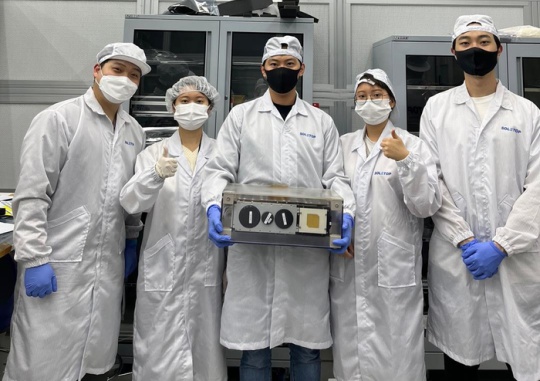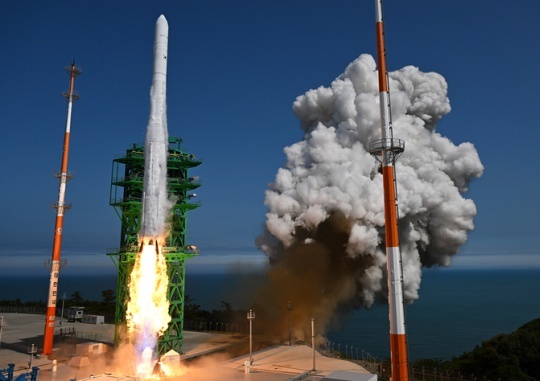Nuri Successfully Released Cube Satellite by Chosun University Team, But Ground Station Confirmed Only Partial Reception of Signals
이 글자크기로 변경됩니다.
(예시) 가장 빠른 뉴스가 있고 다양한 정보, 쌍방향 소통이 숨쉬는 다음뉴스를 만나보세요. 다음뉴스는 국내외 주요이슈와 실시간 속보, 문화생활 및 다양한 분야의 뉴스를 입체적으로 전달하고 있습니다.

The performance verification satellite that went into orbit on the Korean launch vehicle Nuri (KSLV-II) successfully released a (mini) cube satellite created by a team of Chosun University students. The satellite was then able to transmit some information on its status to the ground station. However, researchers believe it may take some time for the satellite to stabilize its position.
The Ministry of Science and ICT and the Korea Aerospace Research Institute (KARI) announced that the cube satellite, STEP Cube Lab-II by the Chosun University team successfully separated at 4:50 p.m. June 29 and that the ground station received some information (beacon signals) on the satellite’s status at 3:48 a.m. June 30.
The information transmitted by the mini satellite included the satellite’s mode, position, GPS status, battery mode, and battery voltage, and according to the information, the battery mode and voltage were fine. Researchers had aimed to communicate with the satellite twenty times, but the ground station only received the signals twice.
Based on the video of the satellite release, the science ministry and KARI said the satellite was tumbling fast. The researchers explained that they managed to receive signals a few times despite that the satellite transmitted information on its status several times.
They said, “To achieve complete two-way communication, it looks like we will need more time for the satellite to stabilize its position.”
The Chosun University cube satellite is scheduled to make its next contact at 3:48 p.m. and 5:26 p.m. June 30. The ground station will receive the status information and send communication commands to the satellite.
The Nuri was loaded with four small satellites developed by four teams of students from Chosun University, the Korea Advanced Institute of Science and Technology (KAIST), Seoul National University and Yonsei University.
An official from the science ministry said, “In the past we launched cube satellites on four occasions using foreign launch vehicles, but failed to succeed in two-way communication. It’s not an easy challenge.”
In the case of the Chosun University cube satellite, the battery mode and voltage are currently in good condition, so experts expect some positive results as long as the satellite manages to stabilize its position.

The science ministry and KARI plan to release the remaining three cube satellites as scheduled while the performance verification satellite attempts to stabilize its position. The smaller satellites are scheduled to be released on July 1 (KAIST), 3 (Seoul National University), and 5 (Yonsei University).
Copyright © 경향신문. 무단전재 및 재배포 금지.
- 윤 대통령, 이재명 대표에 총리 후보 추천 부탁하나…첫 영수회담 의제 뭘까
- 조국혁신당 “윤 대통령, 4·19 도둑 참배” 비판···이재명·조국은 기념식 참석
- 이미주-송범근 ‘열애’ 팬들은 알고 있었다···이상엽도 응원
- 조국·이준석·장혜영 “채 상병 특검법 통과를” 공동회견… 범야권 ‘1호 공조법안’ 되나
- “선거 지고 당대표? 이재명식 정치문법” 한동훈 조기 등판에 부정적인 국민의힘
- 국정원 “‘강남 학원가 마약음료’ 필로폰 총책, 캄보디아서 검거”
- 이스라엘의 군시설 노린 재보복, “두배 반격” 공언 이란 대응 촉각 …시계제로 중동 정세
- [단독]해병대 사령관·사단장, 비화폰으로 수차례 통화…추가 검증은 미제로
- 김재섭 “국민의힘 지지층, ‘젊은 당대표’에 트라우마···난 제2의 이준석 아니다”
- ‘2000명 증원’ 한발 물러선 정부···“원점 재검토” 접을 뜻 없어보이는 의료계